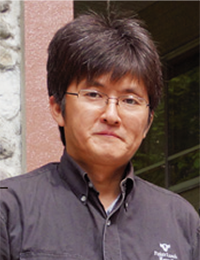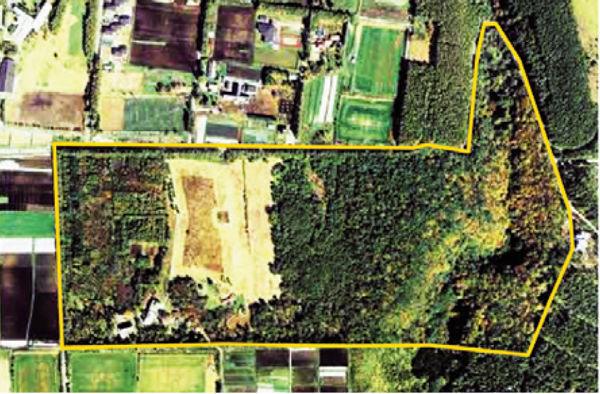キーワード: 生物多様性、進化、相互作用、生態系、環境
 人類に莫大な恩恵をもたらす生物多様性は、ほとんど未知のまま消失の危機にあります。本リサーチユニットは、良好な自然環境が守られた一地点内に生息する全生物相を解明し、全生物間の相互作用ネットワークを網羅的に解析することで、世界で最も生物多様性情報が集約された山岳研究教育フィールドの確立を目指しています。
人類に莫大な恩恵をもたらす生物多様性は、ほとんど未知のまま消失の危機にあります。本リサーチユニットは、良好な自然環境が守られた一地点内に生息する全生物相を解明し、全生物間の相互作用ネットワークを網羅的に解析することで、世界で最も生物多様性情報が集約された山岳研究教育フィールドの確立を目指しています。
そこにいる、全ての生物を知る!
私たちは冷温帯を代表する草原・森林フィールドと過去80年間の生物相データの蓄積を有し、良好な自然環境が守られた菅平高原実験センター(*1)(図1)を舞台に、一地点の全生物相と全生物間相互作用ネットワークを集中的かつ網羅的に解析することを目指しています。ユニットメンバーの専門は、昆虫、その他節足動物、菌類、藻類、植物病理、原生生物など多様で、幅広く生物をカバーしています。また、植物生態学、分子生態学などを専門とするメンバーが、生物同士の関わりを探究しています。菅平高原実験センターという一地点であっても、そこに住むすべての生物を知るというのは簡単にできることではありません。特に、目に見えないサイズの生物まですべて解明しようという試みをしているのは、世界でもここだけです。そこで、多様な生物を相手に研究する100人超の研究者と協同しながら、全生物に関するあらゆるデータの集約を進めています。高度な生物多様性情報を集約することで、例えば新たな生物資源の発見と持続的な活用法の研究、自然と調和した土地利用法の開発といった発展的研究の基礎を作ることができます。
*1:平成29年4月1日、山岳科学センター菅平高原実験所に改称。

図1:菅平高原実験センター(枠内)鳥瞰図
市民から研究者まで、すべての人に生物多様性教育を!
集約された生物多様性情報は、市民も含む全世代への生物多様性教育にも活かされています。自然の中にこそ新たな発見のヒントがある、という理念のもと、応用生物分野や生物以外の分野に進む学生にも、本物の生き物に触れる機会を提供しています。また、本リサーチユニットの成果に基づき、菅平高原実験センターは文部科学省教育関係共同利用拠点「ナチュラルヒストリーに根ざした森と草原の生物多様性教育拠点」に認定されました。今後全国の大学、研究機関が教育研究に活用することで、さらに生物多様性情報が蓄積されるという正の相乗効果を促進していきたいと考えています。

図2:菅平高原の動植物(左上から時計回りに:フクジュソウ、ベニテングタケ、ヒレハリソウの蜜を吸うコマルハナバチの雄、コガラ(上)とシジュウカラ(下)、シカの糞上に生えたミズタマカビ、地衣類コアカミゴケ)
社会への貢献・実績
- 「岩波生物学辞典 第5版」生物分類表 真核生物ドメイン・菌界・アメーバ界・バイコンタ上界・植物界・クロミスタ界ほか(岩波書店)2013 年(pp.1552-1553, 1628-1636, 1652-1666, 1601-1628.)
- 「菌類の事典」接合菌門・子嚢菌門・接合菌門の無性生殖・有害性・その他の病気(野生植物の病気)・(日本菌学会編、朝倉書店)2013 年(21-23, 25-28,100-103, 569-571,594-595 他)
- 上田市、上田市教育委員会後援国際植物の日イベント「来て見て発見!多種多様な植物・私たちの命を支える植物の多様性~その利用と研究」
- 四季の菅平高原実験センター構内自然観察会(年3 回開催)
- 筑波大学菅平高原実験センター、菅平水土里会主催特別講演会「釧路湿原の自然再生事業の紹介―湿原の生態系保全と農業の共存・共生を目指して―」
- JST 委託事業「SS リーグ」小中高校生対象ジェネラル&アドバンストフィールド実習
取材:平成26年6月27日
Elucidation of interactive networks among all biota and organisms
Unit members : Yamaoka, Yuichi Numata, Osamu Nakayama, Takeshi Yahata, Kensuke 鈴木 亮
Unit name:Mountainous Area ATBI (All Taxa Biodiversity Inventory) Project
Keywords: biodiversity, evolution, interaction, ecosystem, environment
 Biodiversity, from which human beings significantly benefit, is on the brink of collapse, although it still remains almost unexplained. The research unit examines all biota that inhabit specific areas in superior natural environments and exhaustively analyzes interactive networks developed among all organisms, with the aim of establishing a field for mountain research and education based on the world’s largest volume of aggregated biodiversity information.
Biodiversity, from which human beings significantly benefit, is on the brink of collapse, although it still remains almost unexplained. The research unit examines all biota that inhabit specific areas in superior natural environments and exhaustively analyzes interactive networks developed among all organisms, with the aim of establishing a field for mountain research and education based on the world’s largest volume of aggregated biodiversity information.
Comprehension of all organisms present in specific areas
The research unit has significant volumes of data on prairie/forest fields representative of cool-temperature zones and biota over the past 80 years, and comprehensively analyzes all biota that inhabit specific areas in Sugadaira Montane Research Center (*1) (Figure 1) surrounded by a superior natural environment and interactive networks developed among all organisms in these areas. Members of the unit specialize in a variety of organism-related fields, including insects, other arthropods, fungi, algae, plant, pathology, and protists. In addition, unit members specializing in plant ecology and molecular ecology conduct research on interactions among many different organisms. It is significantly difficult to understand all organisms living in even a small area of Sugadaira Montane Research Center. The center is the only research institution in the world that conducts research to clarify the characteristics of all organisms, including ones that are so small they are invisible to the naked eye. The research unit aims to collect and organize all types of data on all organisms in collaboration with more than 100 researchers specializing in a variety of organisms. The aggregation of advanced data on biodiversity is conducted to establish foundations for developmental research, including the discovery of new biological resources, research on sustainable methods for their utilization, and the development of methods for the utilization of land in harmony with nature.
*1: Sugadaira Montane Research Center has Changed to “Sugadaira Research Station, Mountain Research Center” since April 1st, 2017.

Figure 1: A bird’s eye view of Sugadaira Montane Research Center (area within the line)
Education on biodiversity for all people, from citizens to researchers
Aggregated information on biodiversity is used for biodiversity education provided for people of all generations including the general public. Based on the philosophy that many clues to new discoveries are hidden in nature, the research unit provides students other than those who wish to specialize in fields such as biology and applied biology with opportunities to interact with real organisms. Sugadaira Montane Research Center has been designated as a Joint Usage/Education Center of the Ministry of Education, Culture, Sports, Science, and Technology: “Center for education on biodiversity in forests and on grassland based on natural history”, based on the results of research conducted by the research unit. We hope that the utilization of information on biodiversity by universities and research institutions across Japan will further promote information collection as a synergistic effect.

Figure 2: Animals and plants on Sugadaira Plateau (clockwise from upper left: pheasant’s eye [Adonis ramosa], fly agaric [Amanita muscaria], male bees [Bombus ardens] sucking honey from Russian comfrey, [Parus montanus] (top) and Great tit [Pilobolus sp.] (bottom), Pilobolus grown on the droppings of deer, lichen [Cladonia macilenta])
Social contributions and achievements
- Biological classification tables from “The 5th Edition of Iwanami Biology Encyclopedia”: Domains of eukaryotes, kingdoms of fungi, amoeba, Bikonta, plants, and Chromista (Iwanami Shoten), 2013 (pp.1552-1553, 1628-1636, 1652-1666, 1601-1628)
- “Encyclopedia of fungi”: Zygomycota, Ascomycota, their asexual reproduction and harmful effects, and other diseases (diseases of wild plants) (edited by the Mycological Society of Japan, Asakura Publishing Co., Ltd.), 2013 (21-23, 25-28,100-103, 569-571, 594-595, etc.)
- An event of the International Day of Plants sponsored by Ueda City and its board of education: “Come and see to discover! A variety of plants/Their diversity to support our lives – Utilization of the diversity of plants and its research”
- Nature observation meetings in Sugadaira Montane Research Center in four seasons (held three times a year)
- Special lecture meeting held by Sugadaira Montane Research Center, the University of Tsukuba, and Sugadaira Midorikai: “Introduction of nature restoration projects in Kushiro Marsh – For the conservation of ecosystems in the marsh in harmony with agriculture”
- JST commissioned project “SS League”: General & advanced field training for elementary, junior high, and high school students
Interviewed on June 27, 2014
